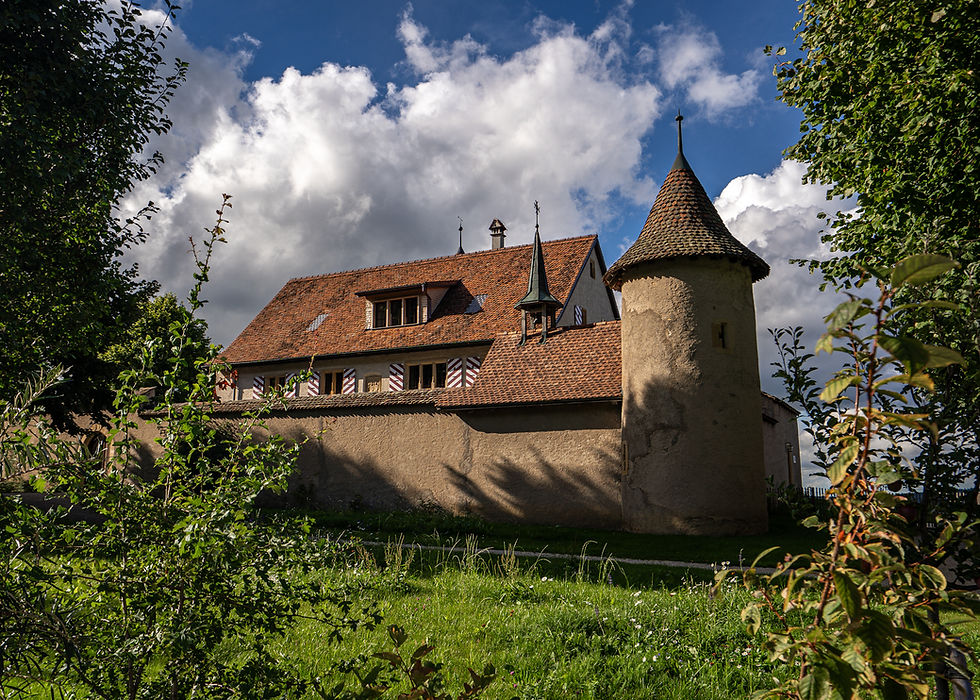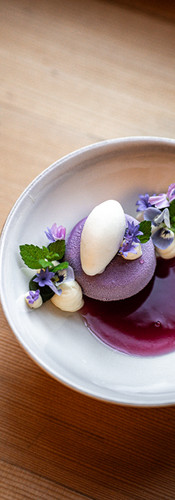Château de Raymontpierre — A Quiet, Extraordinary Castle Retreat in Switzerland’s Jura
- Andrew C.

- Oct 11
- 4 min read
Updated: Oct 12

I arrived in early fall, lucky enough to be the only name on the booking sheet and in the mood to reconnect with myself. After stepping off the train, the road narrowed, the Jura folded in, and then the castle rose on the skyline. Château de Raymontpierre appeared with round towers, red-and-white shutters, and a wall that keeps the world at arm’s length. The gate opened with a sigh, and the hush that lives here, older than any itinerary or trend, took over. Cows drew calm diagonals across a green slope, their bells answering a soft chime from the private chapel. It felt less like checking in, more like being remembered.
The estate runs across 650 hectares of meadows, orchards, and forest, so silence has room to breathe. Built between 1594 and 1596 by Georges Hugué as a fortified manor—with towers, curtain walls, a chapel, and terraces set into Mont Raimeux—the château has been restored with restraint: limewash, old timber, fragments of fresco. Comfort appears exactly where it matters; nothing feels staged.
This is one of Switzerland’s most exclusive and quietly singular castle stays. Every day here turns like a new page in its own fairytale.

Life Within the Ancient Walls
Château de Raymontpierre keeps six rooms and suites inside the château and eight more in La Grange, the modern farmhouse next door, yet it never feels like a hotel—more a timeless residence. My chamber set the tone: hand-troweled plaster, a timber ceiling the color of toasted bread, and deep wooden windows with stone-lined embrasures that frame the view like a painting. A low bouclé chaise caught the afternoon sun; a small writing desk sat exactly where you’d want it, facing a window and quiet fields. The bed was scaled to the room—no oversized bravado—dressed in cool linen with a soft eiderdown and lamps that glow, not glare.
Bathing here is a delicate ritual. A freestanding copper tub anchors the bathroom beneath old beams; leaf-patterned walls soften the light; warm wood floors creak in polite whispers. Towels are thick and soft without being showy. On the lower level, a cedar sauna opens to a small sundeck that looks past the ramparts into the forest—a punctuation mark at day’s end. Every room speaks the same language: measured proportions, well-chosen materials, modern pieces that behave—so the house reads as one thought, quietly expressed.

Set Your Own House Rhythms
Inside the wall sits a chapel built for vows and stillness. Its most disarming detail rests in a shallow niche: a small Madonna and Child beneath a midnight-blue, star-scattered backdrop dated 1598. The polychrome has weathered to velvet; the gilding catches sunlight like a breath. It isn’t something you just view, you actually live with it. Sing a single note and the room would hold it for you. That’s the measure of its intimacy here. Today, it could still cradle a small ceremony for the luckiest lovebirds.
When afternoons settle and the light tilts into the grand salon on the first floor, the stone staircase connects the castle, and the giant beams overhead, the glow draws everyone outside to the edge where lawn meets forest. Conversation thins, the valley exhales, the sun goes down. The quiet here isn’t empty; it’s architecture—stone that absorbs, wood that answers, wind threading corridors and lifting a curtain like a gentle touch. Every moment is slow luxury.

A Culinary Awakening That Listens to the Land
Sydney, Timon, and the team run Raymontpierre at two tempos: the grace guests see and the quiet agriculture beneath it. Dinner starts long before plates hit the table: Sydney and Timon lead a slow garden walk at golden hour, hands brushing dill and nasturtiums as we pick zucchini blossoms into a wicker basket while the farm cows file past the fence like a metronome. Then it’s back beneath the château’s vaulted ceilings where pasta is piped by hand, broths run clear as glass, and the evening goes one of two ways—at the long black table outside on the gravel clearing by the fire ring, or as a private dinner in the salon when the Jura wind turns cool.

What follows reads like the garden speaking in courses: arancini with yuzu to wake the palate; a tomato consommé that tastes of sunlight; zucchini-filled ravioli in shimmering chicken-broth butter; kale gnocchi draped in Bleuchâtel; estate-beef polpette with black garlic; trout with cherry tomatoes and a rustic polenta cake; lamb with yeast-garum hollandaise and embered beetroot. A house aperitif arrives in a coupe crowned with a single nasturtium, and dessert leans floral and light—meadowsweet and lavender, or damasson plum with cream—an honest, quiet feast that moves from soil to fire to table with the ease of a place that grows what it serves.

Old-World Charm, New Sustainable Operations
Heat comes from wood chips. Stone is local. Materials are reused when it makes sense; water rises from springs; food waste becomes golden sauces through fermentation. These are just some of the sustainable practices here. You won’t be toured through any of it; instead, you simply live within a philosophy of longevity. Real sustainability is absorbed into daily comfort so completely you feel right being here—not performed.

The Parting & the Keeping
In many minds, castles are meant to be dramatic. After my experience, Château de Raymontpierre is rarer: cozy, elegant, intelligent, and absolutely itself. On my last morning, cows crossed the lane in procession, the chapel bell caught the sun and cast long shadows across the courtyard, and wind moved through linden leaves like a page turning. Clouds and fog wrapped the property and the valley. There was no sign I was ready to leave; everything had settled and sunk in. When the moment finally came—after a gentle goodbye to the hosts—I closed the gate knowing I’d return—not for spectacle, but for a quiet castle home that holds you close, with people who treat you like family and a landscape that answers every castle dream.
































































































Comments